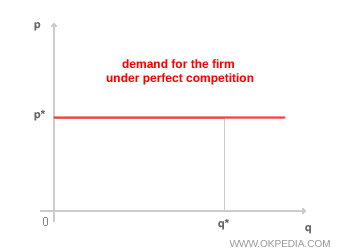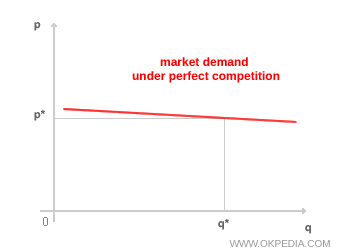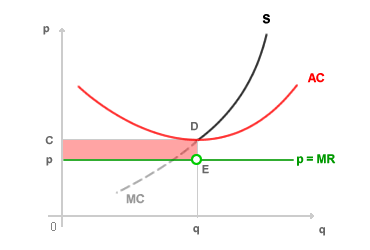Perfect Competition
Perfect competition is a market structure in which neither producers nor consumers can influence the market price of goods and services. It is characterized by a large number of buyers and sellers, each accounting for only a negligible share of total demand or supply. Under these conditions, the actions of any single participant - whether buying or selling - have no impact on the overall market price. In such markets, economic agents are price takers, accepting the price determined through free and simultaneous interaction between buyers and sellers. Economic agents can only decide the quantities of goods or services to demand or supply, but not the price itself.
Key Characteristics
A perfectly competitive market displays the following features:
- Atomistic structure. A vast number of economic agents operate on both the demand and supply side. Each represents only a tiny fraction of the overall market and, acting alone, cannot influence the price of the good or service being exchanged. Participants act independently, without forming groups, collusion, or coalitions.
- Homogeneous products. Goods traded in perfect competition are homogeneous, meaning they are identical or nearly identical in quality and features. As a result, there are no product differences significant enough to create sub-markets. Homogeneous products are exchanged in a single, unified market by a large pool of buyers and sellers.
- Perfect information. Market participants have full and equal access to all relevant information about goods, services, and market conditions. Prices, quality, and terms of exchange are fully known to both consumers and firms, ensuring complete transparency in transactions.
- No barriers to entry or exit. There are no economic, legal, or natural restrictions preventing firms from entering or leaving the market. Entry and exit occur freely and without significant costs. When high (extra) profits appear, new firms are attracted, expanding supply and driving prices and profits down until extra profits are eliminated in the long run. Existing firms cannot form cartels to block new competitors.
- Freedom of choice. Each economic agent - whether producer or consumer - freely decides how much to buy or sell. No external authority dictates quantities, and no collusion takes place between buyers or sellers.
- Perfect rationality. Agents are assumed to act rationally, making decisions that maximize their own benefit. Producers choose output levels to maximize profit, while consumers decide quantities to purchase based on prices, income, and preferences. Under perfect rationality, participants are expected to make the most efficient (optimal) choices to advance their own interests.
- Market fluidity. At the prevailing market price, sellers can sell and buyers can purchase as much as they wish without restriction.
- Homogeneous technology. All firms rely on the same production technology, leaving no room for advantages based on know-how or patents. Identical technology implies identical cost curves for all firms. In the short run, minor differences in cost structures may exist, distinguishing marginal firms from those earning extra profits. In the long run, however, cost structures converge, leaving all firms essentially identical.
The Demand Curve in Perfect Competition
The demand curve facing a perfectly competitive firm is a horizontal line. This reflects the fact that changes in the firm's output cannot affect the market price (the firm is a price taker). The firm's demand curve therefore coincides with both its average revenue and marginal revenue curves. Put simply, under perfect competition the price of a good is equal to the firm's average and marginal revenue.

At the market level, the market demand curve has a slightly different shape. The market demand curve slopes downward from left to right, since the collective behavior of buyers and sellers can influence the overall market price.

To highlight the contrast between the firm's demand curve and the market demand curve, both can be shown on the same Cartesian diagram. If a competitive firm were to set a price above the market level (p > p*), it would lose all of its customers to rivals and sell nothing. If it set a lower price (p < p*), it would capture the entire market demand but lack the capacity to supply it.

The Supply Curve
Producers cannot determine the selling price; they must accept the market price, which emerges from the interaction of buyers and sellers. Given that price is fixed, each producer chooses output where marginal revenue (MR) equals marginal cost (MC) - both equal to the market price in equilibrium. This is why perfect competition is often considered the benchmark of allocative efficiency. The individual firm's supply curve (S) corresponds to the portion of the marginal cost curve (MC) that lies above its intersection with the average cost curve (AC). The selling price (p) must be at least equal to average cost; otherwise, the firm operates at a loss.

The next diagram shows a firm operating at a loss. Equilibrium is reached at point E, where the marginal cost curve (MC) intersects the price line (P). Here, however, average costs (AC) exceed price, so the firm incurs a loss, represented by the area EPCD.

Firms that consistently incur losses exit the market. In the short run, more efficient firms may earn supernormal profits (P > AC). In this case, the price received for each unit sold (p) exceeds the average cost of production (AC).

The presence of supernormal profits attracts new entrants. With no barriers to entry or exit, firms can enter quickly and at relatively low cost. Entry continues until profits are competed away and all firms earn only normal profit. Thus, the long-run equilibrium in perfect competition is reached when price equals average cost across all firms. In the long run, the market price settles at its minimum sustainable level - equal to average production cost - and supernormal profits disappear.

The market supply curve is obtained by aggregating the individual supply curves of all firms. Considering both the total supply of producers and the total demand of consumers makes it possible to analyze market equilibrium and price formation. The equality of aggregate supply and demand determines the market price. This equilibrium is illustrated in the following diagram. The resulting market price is the one applied by every competitive firm.

 Perfect competition is a theoretical model, since in practice markets rarely satisfy all of its assumptions. Real markets often develop concentrations of power - especially on the supply side - and leadership positions that enable certain agents to influence prices. One of the closest real-world examples is the international market for some agricultural commodities.
Perfect competition is a theoretical model, since in practice markets rarely satisfy all of its assumptions. Real markets often develop concentrations of power - especially on the supply side - and leadership positions that enable certain agents to influence prices. One of the closest real-world examples is the international market for some agricultural commodities.
